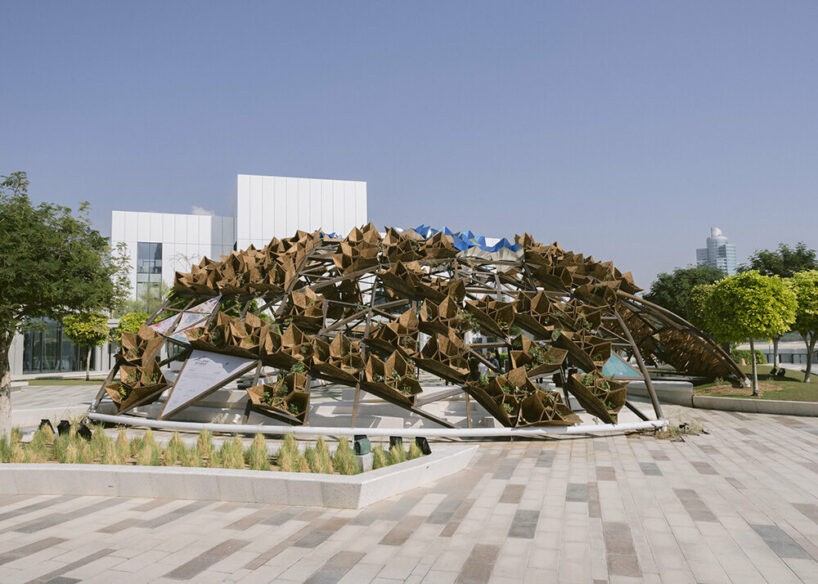Tarabot Pavilion: Weaving a Living Forum – A Sustainable Marvel at COP28, Dubai

In a pioneering initiative aligning with the COP28 UAE conference in Dubai, Art Jameel showcased an extraordinary ecotone-pavilion named Tarabot: Weaving A Living Forum. The brainchild of the talented Beirut-based architect Adib Dada from theOtherDada studio, this modular structure graced the Jaddaf Waterfront Sculpture Park, serving as a hub for talks, presentations, and community programs throughout and beyond the global conference.
Adib Dada envisioned Tarabot as an interspecies ecotone, a convergence where diverse biological communities unite and coalesce. Acting as a shared space for humans and other organisms, this pavilion at Jameel Arts Centre transcends traditional architectural norms. Dada seamlessly wove modular and nested cone components, employing locally sourced sustainable materials, including clay, mycelium, date palm waste, and upcycled fabric.

Fostering Synergies and Circular Ecological Support
The heart of Tarabot lies in its commitment to fostering synergies between the natural world and constructed environments. Each component of the pavilion is a testament to the architect's dedication to sustainability and the creation of circular ecological support systems. Dada's ingenious use of materials sends a powerful message - a rallying call for rejuvenating urban spaces by focusing on hyperlocal resources and integrating circular ecological systems into new and existing structures.
Vision, Pillars, and Legacy of Tarabot
Dada's vision for Tarabot revolves around four essential pillars: Soil, Water, Plants, and Energy. These pillars serve as the foundation of the pavilion and encapsulate its core philosophy, construction methodology, and even its eventual de-installation. Beyond its primary purpose, the modular constituents of Tarabot will be repurposed for domestic planting after de-installation, creating a sustainable life cycle where the structure transforms into an underwater habitat for coral and fish. This seamless link between life on land and underwater showcases a holistic approach to ecological conservation.
For Dada, Tarabot is a groundbreaking project that bridges the gap between building habitats for humans and those for other organisms. The name itself, which translates to 'to weave together,' encapsulates the essence of the pavilion, offering a space where humans and other organisms coexist as interdependent equals, sharing essential resources like food, water, and habitat.

Artistic Dimensions and Living Legacy
Within the Tarabot Pavilion during COP28, visitors had the opportunity to engage with a series of thought-provoking artworks by Dubai-based multidisciplinary artist Solimar Miller. These works, a response to the impact of urbanization on the environment, added an artistic dimension to the pavilion, further underlining the interconnectedness of art, architecture, and environmental consciousness as the Tarabot Pavilion at Jameel Arts Centre stood as a beacon of sustainable architecture during COP28, its lasting impact extends far beyond the conference. It serves as a testament to the potential of harmonious coexistence between urbanity and nature. By offering a space for dialogue, Tarabot becomes a living legacy that educates, inspires, and calls for collective action toward a more sustainable and interconnected future.
In conclusion, Tarabot: Weaving a Living Forum stands as a testament to the power of sustainable architecture, seamlessly blending innovation, art, and environmental consciousness. As it continues to inspire and educate, the pavilion symbolizes hope for a future where human habitats harmonize with the broader ecosystem, ensuring a sustainable legacy for future generations.
Fischer Homes on the Future of Personalized Home Design

Architecture's Response to the Seven Million Homes Shortage

Travis Scott Slams Victory Boyd in Explosive 'Telekinesis' Lawsuit: 'She Lied on Copyright'

From Digital Models to 3D-Printed Homes: Jaspreet Kaur Lall Explains How the Innovation Changes the Construction Industry

Future Belongs to Green Construction: Sampath Kumar Paspunoori Explains One of the Key Trends in the Construction Industry














